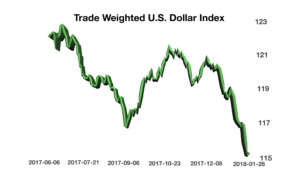Stock Indices:
| Dow Jones | 42,270 |
| S&P 500 | 5,911 |
| Nasdaq | 19,113 |
Bond Sector Yields:
| 2 Yr Treasury | 3.89% |
| 10 Yr Treasury | 4.41% |
| 10 Yr Municipal | 3.31% |
| High Yield | 7.26% |
YTD Market Returns:
| Dow Jones | -0.64% |
| S&P 500 | 0.51% |
| Nasdaq | -1.02% |
| MSCI-EAFE | 17.30% |
| MSCI-Europe | 21.20% |
| MSCI-Pacific | 10.50% |
| MSCI-Emg Mkt | 8.90% |
| US Agg Bond | 2.45% |
| US Corp Bond | 2.26% |
| US Gov’t Bond | 2.44% |
Commodity Prices:
| Gold | 3,313 |
| Silver | 33.07 |
| Oil (WTI) | 60.79 |
Currencies:
| Dollar / Euro | 1.13 |
| Dollar / Pound | 1.34 |
| Yen / Dollar | 144.85 |
| Canadian /Dollar | 0.72 |
How A Decreasing Dollar Is Good For U.S. Exports – Currency Overview
The dollar fell in January to its lowest levels since 2014 as central banks around the world started to reduce monetary stimulus efforts and raise rates.
As the economies and circumstances of individual countries change, so does their ability to export and import. A country’s ability to buy goods and services from other countries is based on the strength of its currency, while a country’s ability to export goods and services is based on the weakness of its currency.
As a nation’s currency lowers in value, relative to another nation’s currency, that country will be able to export more. This may sound counterintuitive, but devaluing a country’s currency is in itself a form of stimulus. The benefits of a devaluing currency for a nation’s economy include an increase in exports, which may result in additional manufacturing and employment.

Since 1995, as the U.S. dollar has devalued, exports have been steadily increasing. As the U.S. dollar has been dropping, U.S. manufactured products have become less expensive for other countries worldwide. This dynamic is an important component for many U.S. companies operating globally.
Sources: Fed, Bloomberg, Commerce Dept.
